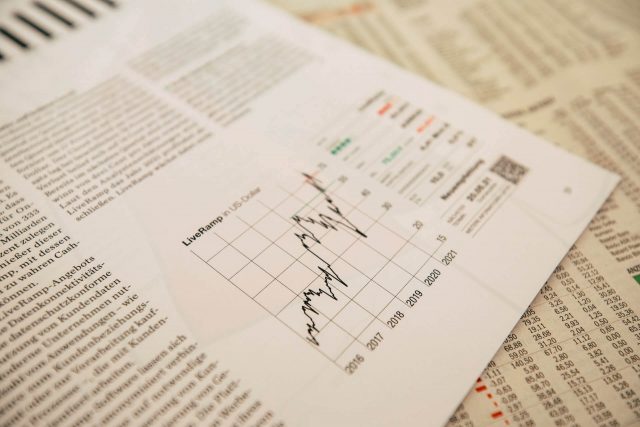
Understanding stock price indicators such as PER (Price Earnings Ratio) and PBR (Price Book Value Ratio) is essential when developing a stock investment strategy. The use of stock price indices cannot be avoided when starting stock investment in earnest.
Therefore, in this article, we will explain in detail the “PER”, which is one of the representative stock price indices that judges whether the stock price is overpriced or undervalued. From the overview of PER, we introduce the difference from PBR, which is often compared, and the information that can be judged from PER. When starting stock investment from now on, please refer to how to use PER and points to be aware of at that time.
- table of contents
-
- PER is an index that can judge whether the stock price is undervalued or overvalued.
- How to use PER for stock investment
- Factors Affecting PER Figures
- Points to note when investing in stocks based on PER
- Using PER as a decision axis for stock investment
1. PER is an index that can judge whether the stock price is undervalued or overvalued

First, let me give you an overview of PER.
1-1. PER basics and formula
PER is an abbreviation of “Price Earnings Ratio”, which means “Price Earnings Ratio” in Japanese. It is used as an index to judge whether the stock price of a particular stock is undervalued or overvalued at a certain point in time.
The formula for calculating PER is “stock price / EPS (net earnings per share)”. For example, if a company’s stock price is 5,000 yen per share and its EPS is 500 yen, the PER is expressed as “10 times.”
Next, let’s take a closer look at what the PER numbers mean.
1-2.What the PER figures represent
When judging the PER figure, one guideline is the number “15 times”. In general, 15 times the PER of a listed company is considered to be a fair price, and if it is less than 15 times, it is considered undervalued, and if it is 15 times or more, it is considered overpriced.
Of course, this number is only a guideline and is not sufficient as a basis for accurately judging whether the price is actually reasonable. Therefore, it is important to analyze the stock price from various perspectives, such as changes in the market environment caused by Japan’s economic growth and recession, comparison of the target company’s past PER and expected PER, and comparison with competitors’ PER. .
In addition, PER can be used not only to judge whether the stock price is undervalued or overvalued, but also to calculate “how many years it will take to recover the investment amount”.
For example, if a company’s stock price is 100,000 yen and its earnings per share (EPS) is 10,000 yen, the PER is 10 times. If you invested in the stock of the same company at that point, you would be able to recoup your investment in 10 years.
However, this calculation is merely the result of a simple calculation based on the stock price and EPS at the time of investment. It is highly unlikely that the stock price and net profit will remain flat for 10 years.
1-3.Difference between PER and “PBR”
A stock price index that is often compared with PER is PBR (price book value ratio). Like PER, PBR is also an indicator that can determine whether the stock price is undervalued or overvalued, but there are some differences, so be careful not to confuse them.
First of all, PER is calculated based on the company’s net income, while PBR is calculated based on net assets.
The formula for calculating PBR is “stock price ÷ BPS (net assets per share)”.
For example, if the stock price is 1,000 yen and the BPS is 500 yen, the PBR will be doubled. As a guideline, PBR is considered expensive when it is 1x or more, and cheap when it is less than 1x.
Also, the two have different investment styles suitable for reference. PER is an index that shows whether the stock price is undervalued or overvalued based on net income, which often fluctuates in a short period of time, so it can be said that it is more suitable for short-term investment stock price analysis than long-term investment. On the other hand, since PBR is based on net assets with little fluctuation, it is an effective indicator for long-term investment with an investment period of 10 years or more.
Both PER and PBR are important indicators in stock investment. You should use it properly depending on the length of the investment period.
2. How to use PER for stock investment

So far, we have seen an overview of PER and its differences from PBR.
Here, let’s take a look at how to actually use PER for stock investment. There are ways to use PER in stock investment, such as “using it as a reference for value investment” and “grasping corporate value.”
2-1. Use as criteria for value investment decisions
As mentioned earlier, PER is an index to understand whether the stock price is undervalued or overvalued. Therefore, it is often used when selecting stocks for “value investment (bargain stock investment)”.
Value investing is the practice of investing in undervalued stocks that are priced below their intrinsic value.
Look for undervalued stocks with a P/E ratio of 15x or less, or against the P/E ratios of competitors and the company’s past P/E ratios.
However, it should be noted that PER is generally lower in industries such as the automobile industry, financial industry, and petroleum industry than in other industries, and that PER tends to be higher in the food, precision equipment, and retail industries.
2-2. Understanding corporate value
You can also use PER to measure the relative corporate value of the target company. In doing so, a method called “comparable company comparison method (multiple method)” is used to calculate corporate value while comparing with similar companies.
The comparable company comparison method is a method of calculating the average corporate value of multiple companies similar to the target company and estimating the corporate value of the target company based on that.
These corporate value figures are generally used as information to determine whether M&A (mergers and acquisitions of companies) are possible. can.
3. Factors affecting PER figures

PER is an index calculated by “Price of stock price / Earnings per share (EPS)”. Let’s see how the PER changes with each change.
3-1. Stock price
As you can see from the PER formula, a rise in the stock price will increase the PER.
The following factors can be cited as factors that affect share price fluctuations.
- Changes in corporate performance
- Changes in the economy and interest rates
- Exchange rate change
There are many factors that affect stock prices. Let’s grasp the trend of the sector in which the company you are paying attention is classified, the economic situation of the whole country, etc., and use it for PER forecast.
3-2.EPS (Net income per share)
EPS is an index calculated by “net income / number of shares issued”. If the EPS increases, the PER will decrease, and if the EPS decreases, the PER will increase.
The factors that cause EPS to fluctuate are as follows.
- Increase/decrease in net income
- share buyback
- reverse stock split
If a company’s net income increases or decreases, EPS will increase or decrease accordingly. Check the financial statements to see how the company is performing. In cases where the decrease in net income is caused by capital investment or new business investment, EPS may decrease temporarily, but may recover after getting back on track.
In addition, if the number of issued shares on the market decreases due to share buybacks and share consolidations, it will increase EPS.
4. Points to note when investing in stocks based on PER

PER is an important indicator in stock investment, especially value investment stock selection, but there are some caveats when using it.
- Stock prices may never recover
- Simply comparing numbers is not enough.
- Compare companies in the same industry
- Some stocks are unsuitable for investment decisions using PER
Let’s take a closer look at the above four points.
4-1. Stock prices may not recover
Compared to similar companies, if the PER figure is low, it can be said to be a “bargain stock”, but this only represents the current stock price.
Even if the current PER is low and seems cheap, if the performance deteriorates in the future and the PER drops further, it will not be a suitable investment target.
When selecting stocks, it is important to make judgments after taking into consideration to some extent the outlook for related factors such as the financial situation of the company, the market and the domestic economy, in addition to the fact that the PER figure indicates that the stock is undervalued.
4-2.Comprehensive judgment based on PER figures
When starting stock investment, it is important to use PER as an indicator. However, as I touched on several times in this article, the PER figure alone is not sufficient as a basis for judging whether a stock is undervalued or overpriced.
On the other hand, just because a company has a high PER doesn’t mean it’s worth investing in.
Therefore, it is necessary to comprehensively judge which stocks to invest in based on the industry average, economic conditions, and stock price trends.
PER should be used to set a rough standard for stock selection. For example, you can efficiently search for promising stocks by setting criteria such as “exclude stocks with a PER of 20 times or more” and “research mainly on stocks with a PER of 15 times or less”.
4-3.Comparing companies in the same industry
However, it should be noted that the average PER differs depending on the industry of the company. This is mainly due to differences in profit margins and cost ratios depending on the industry.
Therefore, if you want to compare PER and measure the appropriateness of stock prices, it is important to compare companies in the same industry.
Below, we introduce the PER figures (as of February 2023) for the main industries in the prime market by industry.
The PER is shown in the table below.
| kinds | average PER |
|---|---|
| Fisheries, agriculture and forestry | 11.1 |
| Construction industry | 10.6 |
| food industry | 18.2 |
| Shipping industry | 2.2 |
| electrical equipment | 17.5 |
| transportation equipment | 14.0 |
| Precision mechanical equipment | 17.3 |
| banking | 9.0 |
As shown in the table above, we can confirm that the PER of the shipping and banking industries is low, while that of the precision equipment and food industries tends to be high. If you use PER as a criterion for stock investment, be careful to compare it with other companies in the same industry.
4-4.Some stocks are unsuitable for investment decisions using PER
There are also stocks that are not suitable for making investment decisions based on PER as an indicator, such as “buying stocks because they are undervalued.” They are “growth stocks” and “economically sensitive stocks”.
4-4-1. Growth stocks (growth stocks)
“Growth stocks” are stocks that are expected to have a high growth rate and can be expected to generate large capital gains in the future.
A prime example of a growth stock for the 2020-2022 period would be Tesla stock.
In such growth stock investment, PER is not suitable as an index for stock selection. This is because growth stocks have high growth potential and high expectations from investors for the future, so the PER figures tend to be higher than the market average.
Conversely, if the P/E ratios of stocks traditionally considered growth stocks are trending downward, it could be a sign of weak earnings or declining investor expectations.
4-4-2. Economic sensitive stocks
It is also difficult to say that PER is the best indicator for “economically sensitive stocks”.
Economically sensitive stocks are stocks whose business performance fluctuates greatly depending on the business climate and economic trends. For example, stocks in the semiconductor, chemical, real estate, steel, and shipping industries fall under this category.
The stock prices of these stocks repeat a cycle of peaking and then declining when the economy is good, and bottoming out when the economy is bad and then gradually recovering. . Due to these peculiarities, “the performance itself is good, but concerns about the coming economic recession are reflected in the stock price, and the PER goes down. However, a phenomenon such as PER increases can occur.
Please be aware that judging whether a stock is undervalued or overpriced based solely on PER may result in erroneous investment decisions.
5. PER as a judgment axis for stock investment
If you’re going to start investing in stocks, it’s very important to make decisions based on stock indices rather than just picking stocks. There are several stock indices, but the PER introduced in this article has long been used as an index to judge whether the stock price is undervalued or overvalued.
There are cases where investment decisions using PER, such as growth stocks and economic sensitive stocks, are not suitable for investment decisions.
Please refer to the contents of this article and understand how to use PER and points to note, and use it to make decisions such as “whether the company’s stock price is undervalued or overvalued” and “whether the corporate value is high”.
What is PER (Price Earnings Ratio) that even beginners of stock investment can understand? Our Bitcoin News.


